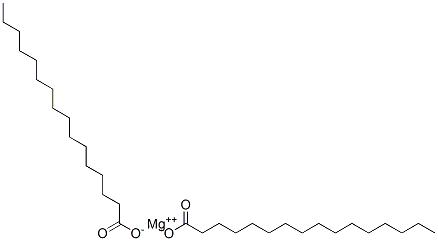Sodium Palmitate
Synonym(s):Hexadecanoic acid sodium salt;Palmitic acid sodium salt
- CAS NO.:408-35-5
- Empirical Formula: C16H31NaO2
- Molecular Weight: 278.41
- MDL number: MFCD00002749
- EINECS: 206-988-1
- SAFETY DATA SHEET (SDS)
- Update Date: 2025-12-17 09:50:31

What is Sodium Palmitate?
Chemical properties
white powder
Chemical properties
Sodium palmitate, white solid, soluble, froth or foam upon shaking the H2O solution (soap), formed by reaction of NaOH and palmitic acid (in alcoholic solution) and evaporating. Used as a source of palmitate.
The Uses of Sodium Palmitate
Sodium palmitate (PA) has been used:
- to induce inflammation and thrombosis pathway in murine macrophage cell line RAW 264.7 cell line by activating reactive oxygen species (ROS) production, Janus-kinase (JNK) signalling and release of histone H3 by western blotting and cell viability by MTT assay
- to induce lipogenesis in AML12 cells and primary hepatocytes to analyse the effect of irisin on PA induced lipogenesis and related signal pathways by western blot analysis and quantitative PCR analysis
- as a component in free fatty acid mixture to induce cellular steatosis in HepG2 cell lines and determination of lipid accumulation by Oil-Red-O staining
The Uses of Sodium Palmitate
Polymerization catalyst for synthetic rubbers, laundry and toilet soaps, detergents, cosmetics, pharmaceuticals, printing inks, and as an emulsi- fier.
The Uses of Sodium Palmitate
Sodium Palmitate is the sodium salt of palmitic acid. It functions as a binder, emulsifier, and anticaking agent.
What are the applications of Application
Sodium palmitate is a common saturated fatty acid
Hazard
A poison. Combustible.
Biochem/physiol Actions
Sodium palmitate is the sodium salt of palmitic acid, a component in hard soaps. Palmitic acid is a common saturated fatty acid and produced during fatty acid synthesis. Sodium palmitate enhances lipogenesis, cellular steatosis in various cell lines. Palmitate induces cell death in human epidermal growth factor receptor 2 (HER2)/neu-positive cells and breast cancer cell lines like MCF-7 due to enhanced fatty acid accumulation. Sodium palmitate induces lipoapoptosis in L02 and HepG2 liver cells by inducing glycogen synthase kinase-3β (GSK3β) expression.
Safety Profile
A poison by intravenous route. Mutation data reported. When heated to decomposition it emits acrid smoke and irritating fumes.
Purification Methods
It crystallises from EtOH and is dried in an oven. [Beilstein 2 IV 1157.]
Properties of Sodium Palmitate
| Melting point: | 283-290 °C (lit.) |
| storage temp. | 2-8°C |
| solubility | very faint turbidity in hot EtOH50vol% |
| form | Powder |
| color | White |
| BRN | 3575882 |
| CAS DataBase Reference | 408-35-5(CAS DataBase Reference) |
| EPA Substance Registry System | Hexadecanoic acid, sodium salt (408-35-5) |
Safety information for Sodium Palmitate
| Signal word | Warning |
| Pictogram(s) |
 Exclamation Mark Irritant GHS07 |
| GHS Hazard Statements |
H319:Serious eye damage/eye irritation |
| Precautionary Statement Codes |
P280:Wear protective gloves/protective clothing/eye protection/face protection. P305+P351+P338:IF IN EYES: Rinse cautiously with water for several minutes. Remove contact lenses, if present and easy to do. Continuerinsing. P337+P313:IF eye irritation persists: Get medical advice/attention. |
Computed Descriptors for Sodium Palmitate
New Products
4,4-Difluoropiperidine hydrochloride tert-butyl 9-methoxy-3-azaspiro[5.5]undecane-3-carboxylate Indole Methyl Resin N-Isopropylurea N,N-Dicyclohexylcarbodiimide(DCC) MELDRUMS ACID 5-METHYLISOXAZOLE-4-CARBOXYLIC ACID Magnessium Bis glycinate Zinc ascorbate 1-bromo-2-butyne 2-acetamidophenol 9(10H)-anthracenone Erythrosin B, 4-Piperidinopiperidine 2-((4-morpholinophenylamino) (methylthio) methylene) malononitrile 2,4-dihydroxybenzaldehyde 3-(4-morpholinophenylamino)-5-amino-1H-pyrazole-4-carbonitrile Methyl 2-methylquinoline-6-carboxylate 2,6-dichloro-4-nitropyridine 4-Bromo-2-chlorobenzonitrile 2-(benzylamino)acetic acid hydrochloride 4-(tert-Butoxycarbonylamino)but- 2-ynoic acid 3,4-dihydro-2H-benzo[b][1,4]dioxepine 1-Phenyl-1-cycloprppanecarboxylicacidRelated products of tetrahydrofuran








You may like
-
 408-35-5 99%View Details
408-35-5 99%View Details
408-35-5 -
 Palmitic acid sodium salt 95% CAS 408-35-5View Details
Palmitic acid sodium salt 95% CAS 408-35-5View Details
408-35-5 -
 Sodium Palmitate CAS 408-35-5View Details
Sodium Palmitate CAS 408-35-5View Details
408-35-5 -
 Sodium palmitate CAS 408-35-5View Details
Sodium palmitate CAS 408-35-5View Details
408-35-5 -
 Sodium Palmitate Cas 408 35 5, Industrial GradeView Details
Sodium Palmitate Cas 408 35 5, Industrial GradeView Details
408-35-5 -
 20677-73-0 (2,2-diethoxyethyl)methylamine 98%View Details
20677-73-0 (2,2-diethoxyethyl)methylamine 98%View Details
20677-73-0 -
 3-(4-(hydroxyamino)-1-oxoisoindolin-2-yl)piperidine-2,6-dione 98%View Details
3-(4-(hydroxyamino)-1-oxoisoindolin-2-yl)piperidine-2,6-dione 98%View Details -
 57381-49-4 2-bromo-4-chlorobenzonitrile 98%View Details
57381-49-4 2-bromo-4-chlorobenzonitrile 98%View Details
57381-49-4
